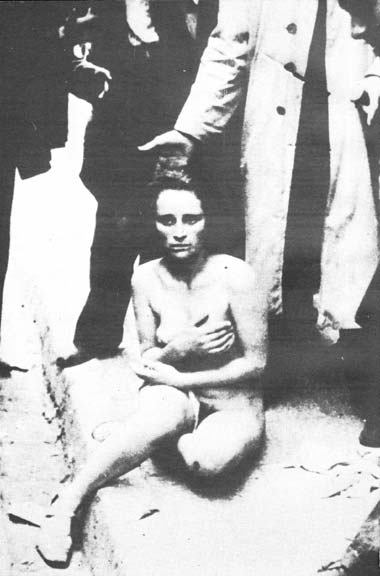 Archive
photo from the book “Heydrich”, by Alan Wykes Archive
photo from the book “Heydrich”, by Alan Wykes |
SURVIVOR:
THE STATIONS OF THE CROSS
The year 2005 marked 60 years since the allied soldiers of WWII cast open
the doors to the death camps of Hitler’s Germany and stunned the
world with the first photographs of industrialized mass murder - 20th
century images equaled only by the Armageddon tower of the A-bomb.
This body of work was created as a response to a voyage I took to research
Holocaust memorials during my studies at the School of the Art Institute
of Chicago. It is a collaborative piece. It is an exorcism. It is itself
a memorial.
Struck numb by what I had seen in the ruins of the Nazi Archipelago,
I contacted a longtime friend, photographer James Riegel. We began devising
a way out of the little cage of horror that had enveloped me while I had
studied the evidence left behind by the brief but extremely brutal rampage
of the Thousand Year Reich.
After being exposed to images of thousands of naked, Godforsaken people
herded through the machine of dehumanization, I drew on my experience
as a theater artist: I stripped myself also and performed a ritual passage
through the Extermination System in a free-form replication of the stations
of the cross performed so long ago by that most famous Jew of all.
It seemed only correct to confront Evil just as those individuals had
- without any of the little, carefully arranged pieces of cloth - our
articles of clothing - that so define our station in the civilized world.
Jim took the pictures; we edited them down to 23.
In conclusion, there is something disconcerting in the fact that Adolf
Hitler, nee Schickelgruber, had been an aspiring artist. True, his sweet
and sterile drawings of an idealized reality were lackluster, however,
had he been accepted rather than rejected by the Art Academy in Vienna,
perhaps we would have been spared the phantasmagoric, grandiose, grotesque
and ghoulish vision of the world created by the most notorious, dare I
say, conceptual artist of the past century.
To your left you see a haunting image - a photograph of a woman taken
during a pogrom in Lemberg in 1942;
I dedicate this book to her - this anonymous human being;
I commemorate her - alone, frightened, utterly abandoned -
and I will never forget her.
S. Rungis |